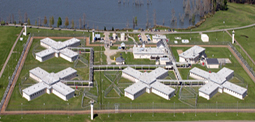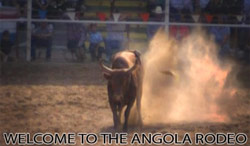Angola State Prison: A Short History

Angola State Prison.
Courtesy Louisiana State Department of Corrections
Angola State Prison was located on land that was originally an 8,000-acre plantation in West Feliciana Parish, in a remote region of Louisiana. The nearest town was 30 miles away. The plantation was named Angola, after the homeland of its former slaves. It traced its origins as a prison back to 1880, when inmates were housed in the old slave quarters and worked on the plantation. In those years, a private firm ran the state penitentiary. After news reports of brutality against inmates, the state of Louisiana took control of Angola in 1901.
Throughout the ensuing decades, Angola State Prison faced numerous problems thanks to its geography and administration. The penitentiary was bounded on three sides by the Mississippi River. In 1902, 1912, and 1922, floods destroyed the crops—a key source of funding for the penitentiary’s operating costs. During the Great Depression, the prison facilities fell into poor shape after its budget was cut severely. Conditions became so bad that 31 inmates sliced their Achilles tendons to publicize their objections to hard labor and brutality. In the 1950s, a new governor fulfilled his campaign promise to clean up Angola, renovate the old buildings, and add new camps—as the prison buildings were called.
In the 1960s, Angola once more fell on hard times and was christened “the bloodiest prison in the South” because of the high rate of inmate assaults. Again, the penitentiary saw major renovations, improvement in medical care, and other upgrades. By the 1990s, the prison was accredited by the American Correctional Association, a recognition of its adherence to national standards for jails. In 1999, the US Army Corps of Engineers began a four-phase project to improve the nearby levees at a cost of $26 million.
By 2008, Angola State Prison had grown to 18,000 acres—the size of Manhattan. It was a maximum-security prison with an inmate population that was almost completely African-American, while the officers who oversaw them were entirely white. The officers were known as “Freemen,” not guards.

Angola Rodeo.
Courtesy Louisiana State Department of Corrections
Angola had numerous enterprises: corn, cotton, soybean, and wheat crops; a license tag plant; printing services; a mattress factory (including suicide prevention mattresses); and a herd of 1,600 cattle. Since 1965, the prison had held a professional rodeo to entertain its inmates, employees, and the general public. Inmates participated in all but one of the events. A portion of the proceeds went toward the Louisiana State Penitentiary Inmate Welfare Fund, which paid for inmate educational and recreational supplies.
One could call Angola a company town. Anyone who worked at the prison lived in one of the hundreds of homes on prison property. The best behaved inmates—called “house boys” by the wardens—wore white uniforms, performed the landscaping work, and cooked and cleaned the houses, all at no cost to the residents. Other inmates who demonstrated good conduct worked in the fields.
The prison and its employees were part of a tight-knit community, one that Sullivan would find difficult to pry open for leads.